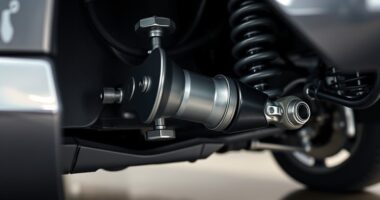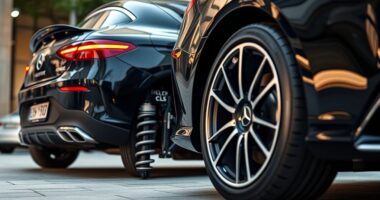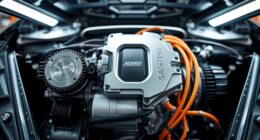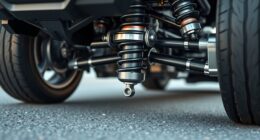To unlock the 2025 Mercedes-AMG GT’s ultimate power, focus on tuning its engine, transmission, and cooling systems for peak performance. Remap the ECU for higher horsepower and smoother shifts, upgrade the turbochargers, and enhance the hybrid system for extra boost. Reduce weight with carbon fiber components and improve aerodynamics for better stability. Balancing reliability with these mods is key. Keep exploring to discover more advanced tips to maximize your GT’s performance.
Key Takeaways
- Reprogram the ECU for increased horsepower, torque, and peak power duration, surpassing 805 hp and 638 ft/lbs.
- Upgrade cooling systems and heat management components to sustain high-performance driving and prevent overheating.
- Enhance aerodynamics and reduce weight with carbon fiber body panels and active aerodynamic features for stability at high speeds.
- Optimize transmission and electronic controls for rapid shifts, instant torque, and seamless power delivery during aggressive driving.
- Implement forced induction upgrades and exhaust modifications to boost airflow, responsiveness, and overall engine output.
Enhancing the Engine’s Performance Capabilities
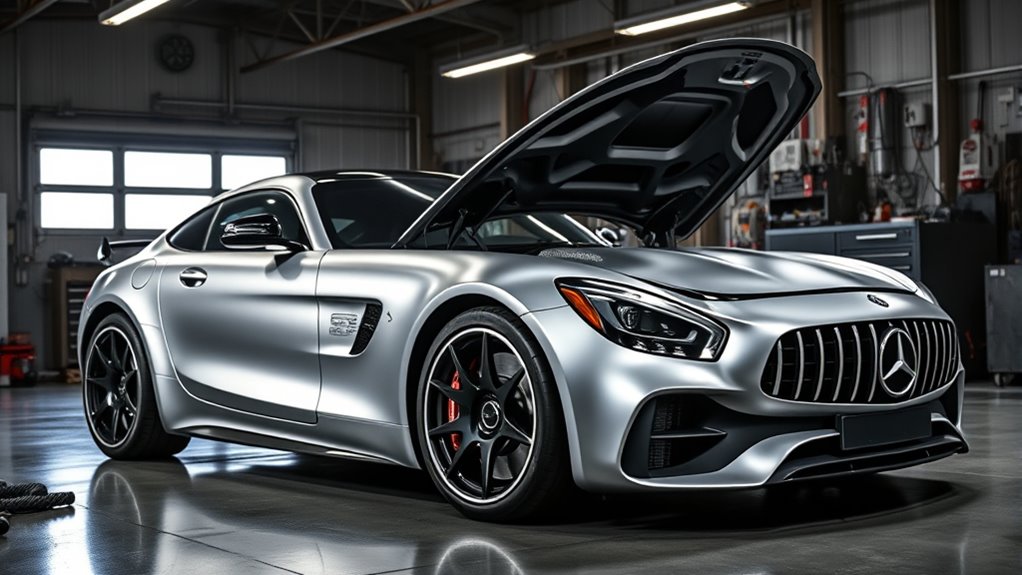
To enhance the engine’s performance capabilities in the 2025 Mercedes-AMG GT, you need to focus on both the hybrid powertrain and the twin-turbo V8 engine.
Reprogram the electric motor’s torque delivery to sustain peak power beyond 10 seconds, boosting overall output past 805 hp.
Reprogram electric motor torque to maintain peak power beyond 10 seconds, surpassing 805 hp.
Upgrade the high-voltage battery cooling system to extend electric motor’s full-throttle duration and reduce power tapering.
Use lightweight, high-performance cells in the 400V battery to improve energy density and discharge rates.
Optimize motor-generator unit (MGU) mapping for instant torque during launch control.
Additionally, implement hybrid-specific ECU tuning to seamlessly blend the ICE-V8 and electric motor power curves, maximizing responsiveness and power delivery.
This process can also benefit from advanced battery management systems to ensure optimal performance and longevity of the hybrid components. Incorporating thermal management techniques further enhances battery efficiency and safety under high loads.
These modifications push performance boundaries while maintaining reliability.
Optimizing Transmission for Rapid Shifts and Power Delivery
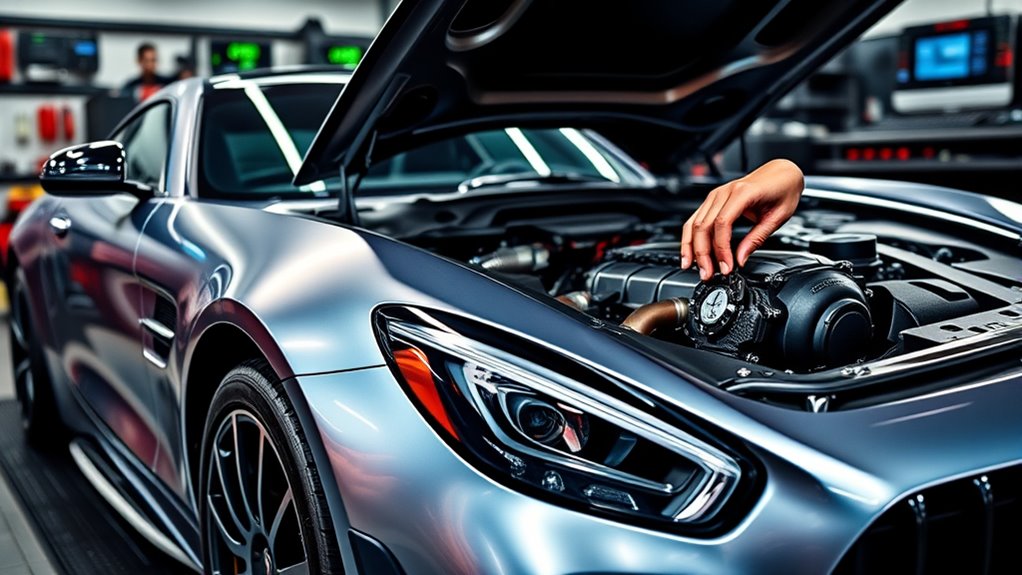
Optimizing the transmission in the 2025 Mercedes-AMG GT is crucial for delivering rapid shifts and seamless power delivery. You benefit from the AMG SPEEDSHIFT MCT 9-speed transmission, featuring a wet start-off clutch that reduces weight and inertia. This setup enables lightning-fast shifts, giving you a more engaging drive. Shift paddles on the steering wheel allow immediate control, while advanced algorithms adapt shift timing based on your driving style and conditions. The system draws from racing tech, ensuring high responsiveness and precision. Additionally, Jeep Tuning techniques such as performance ECU remapping can be similarly applied to enhance overall vehicle responsiveness and power output. Proper maintenance and understanding of automotive repair fundamentals can further optimize your vehicle’s performance and longevity.
| Driving Mode | Power & Shift Behavior |
|---|---|
| Comfort | Smooth, relaxed shifts |
| Sport | Faster, more aggressive shifts |
| Track | Maximum responsiveness |
Upgrading Cooling Systems for Sustained High-Performance Driving

Upgrading the cooling system in your 2025 Mercedes-AMG GT boosts its ability to handle sustained high-performance driving. A well-designed radiator, matched with high-efficiency fans and shrouds, ensures maximum heat dissipation.
Improving coolant flow rates enhances the “scrubbing action” inside radiator tubes, preventing heat buildup during intense driving. Choosing advanced materials like aluminum or copper for the radiator boosts heat exchange efficiency.
Incorporating liquid cooling systems and heat exchangers elevates heat transfer, keeping engine temperatures stable under stress. High-performance fans provide ideal airflow, while innovative radiator designs, such as RIGID Alphacoolers, tailor cooling solutions for racing conditions.
Proper airflow management and system pressure are crucial for maintaining optimal cooling capacity, especially under high horsepower loads. Utilizing advanced cooling technologies can further optimize heat management and improve overall engine performance.
Implementing effective thermal management techniques ensures consistent cooling performance during demanding driving sessions. These upgrades help maintain engine reliability, prevent overheating, and support prolonged high-performance driving without sacrificing efficiency or durability.
Fine-Tuning Electronics and Hybrid Systems for Maximum Output
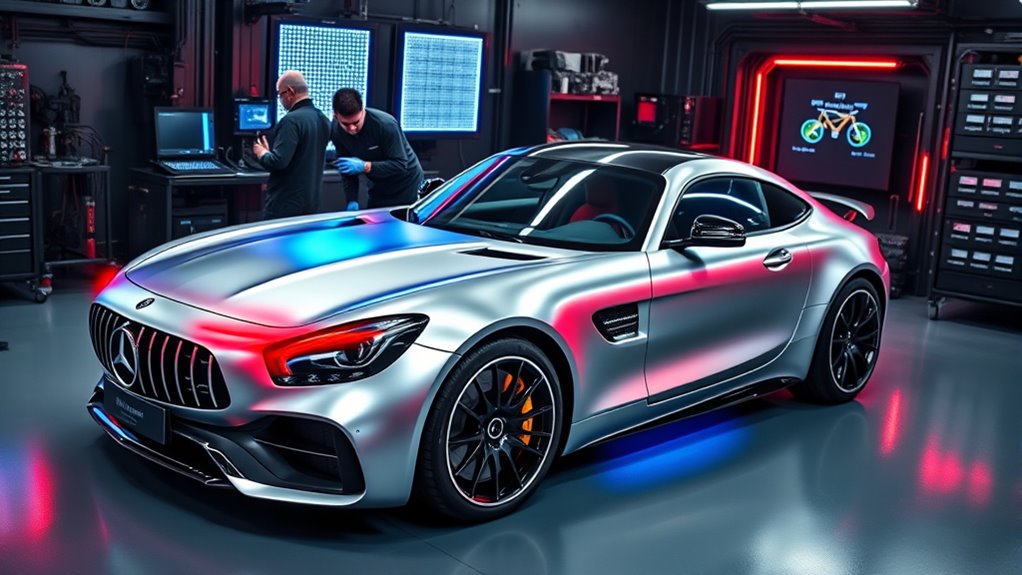
Fine-tuning the electronics and hybrid systems of your 2025 Mercedes-AMG GT can unleash significant performance gains. ECU tuning boosts throttle response, horsepower, and torque—raising power from 523 HP to 625 HP and torque from 494 ft/lbs to 638 ft/lbs. Many providers offer remote tuning, making adjustments easier. Some models need a CPC tune for peak results. Hybrid integration adds electric boost, recovers energy during braking, and enhances overall power. Additionally, the hybrid system’s advanced electronic controls require precise calibration to ensure safety and reliability. Proper calibration of hybrid system components is essential to optimize both performance and efficiency. These calibrations involve complex electronic control adjustments that demand skilled expertise. However, it requires sophisticated electronic control and increases costs. Here’s a quick comparison:
| Aspect | Impact |
|---|---|
| ECU Tuning | Increased horsepower and torque |
| Hybrid System Integration | Boosts power with electric support, adds complexity |
| Tuning Complexity | Demands precise calibration for safety and efficiency |
Implementing Weight Reduction Techniques to Improve Acceleration
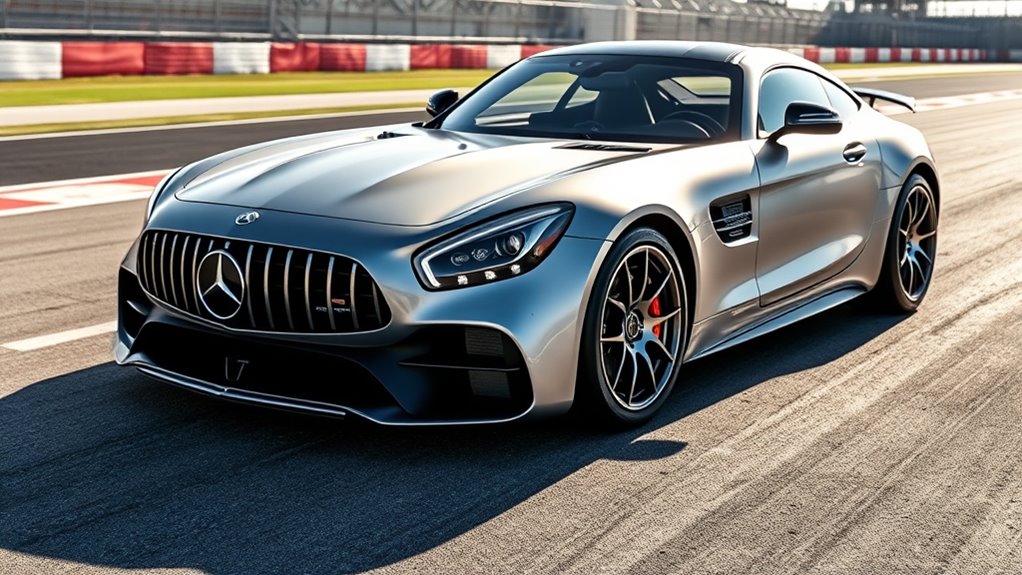
Implementing weight reduction techniques is a proven way to boost your Mercedes-AMG GT’s acceleration and handling.
By replacing body panels with carbon fiber, you can shed significant weight—such as the 661 lbs cut in the IMSA RXR AMG GT S conversion. Carbon-fiber components like the torque tube and driveshaft reduce mass while increasing rigidity and torque handling. Carbon fiber technology has advanced to allow for stronger, lighter parts that can withstand high stress. Using lightweight materials like aluminum, magnesium, and forged aluminum in the chassis and suspension further cuts weight without sacrificing strength. Additionally, understanding AI safety measures can help ensure that modifications are tested for safety and reliability in high-performance vehicles. Incorporating lightweight materials in the vehicle’s construction not only reduces weight but also enhances overall durability and performance.
Stripping interior components, replacing heavy trim, and opting for lightweight seats and wiring diminishes mass inside the cabin.
These strategies improve your car’s power-to-weight ratio, enhance throttle response, and enable quicker acceleration and sharper handling.
Every ounce saved makes a noticeable difference in performance.
Customizing Aerodynamic Features for Increased Downforce and Stability
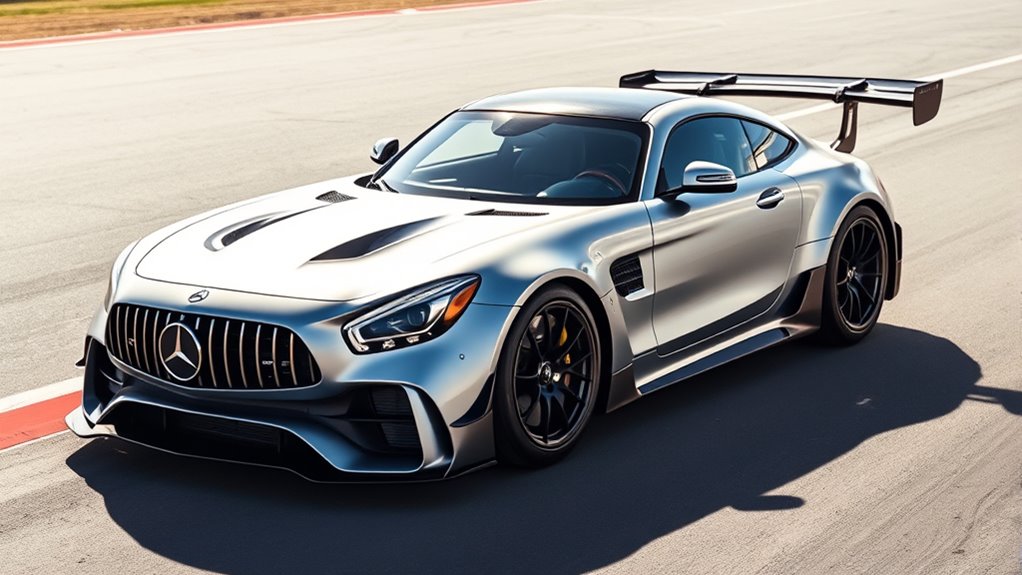
To maximize your Mercedes-AMG GT’s stability at high speeds, customizing its aerodynamic features is essential. The front fascia and air intakes are designed to optimize airflow, reducing lift and increasing downforce. Handcrafted AMG 4.0L biturbo V8 engine with 603 hp Enlarged side air intakes improve cooling and air channeling, while the deep AMG radiator grille enhances airflow management. Active aerodynamic systems like the AIRPANEL adjust air flaps in real time, balancing cooling with drag reduction. The multistage rear spoiler increases downforce during high-speed driving and adapts during braking or cornering for added stability. Underbody aero fins and a flat underbody direct airflow, lowering turbulence and boosting ground effect. Carbon fiber components further optimize airflow while reducing weight, ensuring your AMG GT remains stable and planted at top speeds.
Integrating Aftermarket Modifications for Power Gains

Maximizing your Mercedes-AMG GT’s performance involves more than just aerodynamic tweaks; integrating aftermarket modifications can unleash significant power gains.
You can enhance engine output through several key upgrades:
- ECU Tuning and Remapping: Reprogram your ECU to optimize air/fuel ratios, boost pressure, and sensor inputs. Custom tunes unlock 50-150+ HP, with options for race-ready or CARB-compliant maps. ECU remapping is a common method to increase power and responsiveness.
- Turbocharger and Forced Induction Upgrades: Larger or hybrid turbos, along with upgraded intercoolers and wastegates, boost airflow and maintain consistent pressure under load, increasing responsiveness.
- Exhaust and Intake Enhancements: High-flow downpipes, valved exhaust systems, and cold-air intakes reduce restrictions, improve spool times, and add horsepower, transforming your GT’s sound and performance.
Balancing Power and Reliability Through Comprehensive Tuning
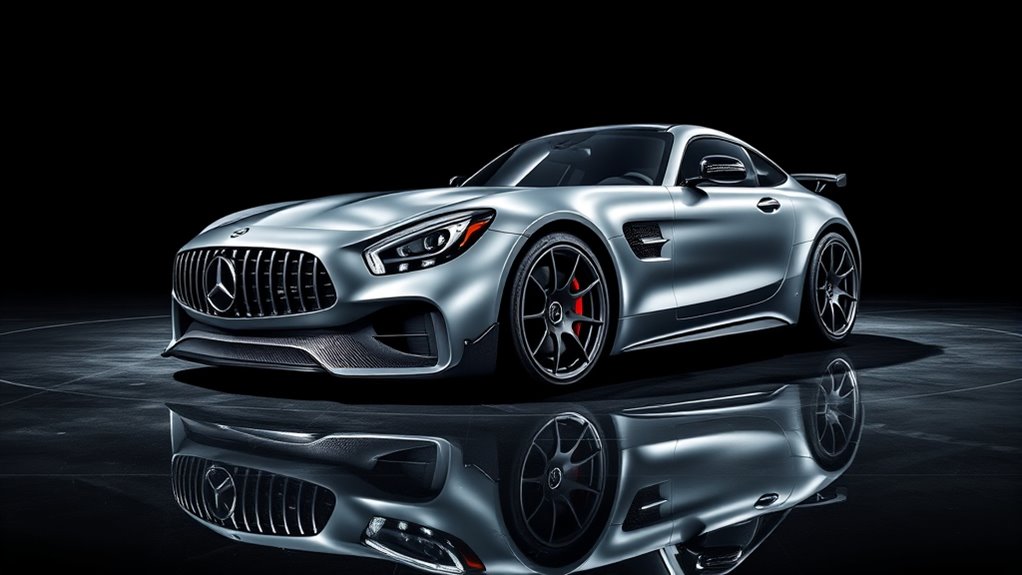
Achieving the perfect balance between power and reliability requires a thorough approach to tuning your Mercedes-AMG GT. You need to optimize the engine with software updates that improve combustion efficiency, while refining the transmission for smoother, quicker gear shifts. The 2025 AMG GT features a turbocharged V8 engine that benefits greatly from precise calibration to maximize performance. Electronic enhancements like slip control systems help manage traction without sacrificing performance. Ensuring the air-fuel mixture is ideal boosts power without risking engine damage. Upgrading the exhaust system improves flow, but you must also address heat management to prevent overheating during intense driving. Software calibration ensures reliable power delivery under different conditions. Rigorous testing confirms durability, and understanding manufacturer warranties helps protect your investment. This extensive tuning balances increased power with the need for longevity, ensuring your AMG GT performs at its best without compromising reliability.
Frequently Asked Questions
How Does Tuning Affect the Car’s Long-Term Reliability?
Tuning your car can boost performance, but it also puts extra strain on engine parts and electrical systems over time. You might notice increased wear, higher maintenance costs, and potential reliability issues, especially if done improperly.
To keep your vehicle dependable, make certain professional tuning, regular maintenance, and careful selection of upgrades. Remember, pushing your car’s limits can shorten its lifespan if you don’t balance power with durability.
Can Aftermarket Modifications Void the Manufacturer’s Warranty?
You might wonder if aftermarket modifications can void your warranty. Under the Magnuson-Moss Act, they usually won’t unless proven that the mods caused the issue.
Dealers might claim they do, but they need to show a direct link. Keep detailed records, and know your rights.
What Legal Considerations Exist for Tuning and Aftermarket Upgrades?
Imagine pushing your car to its limits, but hidden legal pitfalls could catch you off guard. When you tune or upgrade your vehicle, you must consider local laws, emissions standards, and manufacturer approvals.
Failing to do so risks fines, vehicle seizure, or voiding your warranty. Always check regulations, pass inspections, and consult experts to guarantee your modifications stay within the law.
How Does Tuning Impact Fuel Efficiency and Emissions?
You might wonder how tuning affects fuel efficiency and emissions. When you tune your car, especially with Stage 1 upgrades, it can improve fuel economy by optimizing the ECU and throttle response, often using premium fuel.
However, higher power levels from advanced tuning can increase fuel consumption and emissions. Reputable tuners balance performance gains with emissions standards through precise calibration, ensuring your car remains efficient and compliant while delivering more power.
Are There Recommended Maintenance Protocols After Tuning Modifications?
After tuning your vehicle, you should follow specific maintenance protocols to guarantee ideal performance.
Regularly check your dashboard for warning lights and use diagnostic tools to monitor system health.
Keep tire pressure, alignment, and suspension in check, and use high-quality fluids like synthetic oils and AMG-approved lubricants.
Additionally, maintain exterior and interior details to preserve your car’s appearance and protect its luxurious features.
Conclusion
So, there you have it—your ticket to turning the 2025 Mercedes-AMG GT into a street-legal rocket. Just remember, more power means more fun, but also more chances to break a sweat (or a part). Tuning isn’t just about chasing numbers; it’s about balancing thrill with reliability—because nobody wants a high-speed dance with disaster. Enjoy your upgraded beast responsibly, or at least pretend you will. Happy racing!




